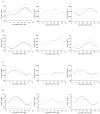Circadian rhythm profiles in women with night eating syndrome
- PMID: 19150931
- PMCID: PMC3564642
- DOI: 10.1177/0748730408328914
Circadian rhythm profiles in women with night eating syndrome
Abstract
Night eating syndrome (NES) is characterized by evening hyperphagia and frequent awakenings accompanied by food intake. Patients with NES display a delayed circadian pattern of food intake but retain a normal sleep-wake cycle. These characteristics initiated the current study, in which the phase and amplitude of behavioral and neuroendocrine circadian rhythms in patients with NES were evaluated. Fifteen women with NES (mean age +/- SD, 40.8 +/- 8.7 y) and 14 control subjects (38.6 +/- 9.5 y) were studied in the laboratory for 3 nights, with food intake measured daily. Blood also was collected for 25 h (every 2 h from 0800 to 2000 h, and then hourly from 2100 to 0900 h) and assayed for glucose and 7 hormones (insulin, ghrelin, leptin, melatonin, cortisol, thyroid-stimulating hormone [TSH] and prolactin). Statistical analyses utilized linear mixed-effects cosinor analysis. Control subjects displayed normal phases and amplitudes for all circadian rhythms. In contrast, patients with NES showed a phase delay in the timing of meals, and delayed circadian rhythms for total caloric, fat, and carbohydrate intake. In addition, phase delays of 1.0 to 2.8 h were found in 2 food-regulatory rhythms-leptin and insulin-and in the circadian melatonin rhythm (with a trend for a delay in the circadian cortisol rhythm). In contrast, circulating levels of ghrelin, the primary hormone that stimulates food intake, were phase advanced by 5.2 h. The glucose rhythm showed an inverted circadian pattern. Patients with NES also showed reduced amplitudes in the circadian rhythms of food intake, cortisol, ghrelin, and insulin, but increased TSH amplitude. Thus, patients with NES demonstrated significant changes in the timing and amplitude of various behavioral and physiological circadian markers involved in appetite and neuroendocrine regulation. As such, NES may result from dissociations between central (suprachiasmatic nucleus) timing mechanisms and putative oscillators elsewhere in the central nervous system or periphery, such as the stomach or liver. Considering these results, chronobiologic treatments for NES such as bright light therapy may be useful. Indeed, bright light therapy has shown efficacy in reducing night eating in case studies and should be evaluated in controlled clinical trials.
Figures



References
-
- Allan JS, Czeisler CA. Persistence of the circadian thyrotropin rhythm under constant conditions and after light-induced shifts of circadian phase. J Clin Endocrinol Metab. 1994;79:508–512. - PubMed
-
- Allison KC, Ahima RS, O’Reardon JP, Dinges DF, Sharma V, Cummings DE, Heo M, Martino NS, Stunkard AJ. Neuroendocrine profiles associated with energy intake, sleep, and stress in the night eating syndrome. J Clin Endocrinol Metab. 2005;90:6214–6217. - PubMed
-
- Allison KC, Lundgren JD, O’Reardon JP, Martino NS, Sarwer DB, Wadden TA, Crosby RD, Engel SG, Stunkard AJ. The Night Eating Questionnaire (NEQ): Psychometric properties of a measure of severity of the night eating syndrome. Eat Behav. 2008;9:62–72. - PubMed
-
- Allison KC, Martino NS, O’Reardon JP, Stunkard AJ. CBT treatment for night eating syndrome: A pilot study. Obes Res. 2005;13:A83.
-
- Allison KC, Stunkard AJ, Thier SL. Overcoming Night Eating Syndrome: A Step-by-Step Guide to Breaking the Cycle. Oakland, CA: New Harbinger; 2004.
Publication types
MeSH terms
Grants and funding
- R01-DK56735/DK/NIDDK NIH HHS/United States
- R01 DK056735/DK/NIDDK NIH HHS/United States
- P01-DK49250/DK/NIDDK NIH HHS/United States
- R01 NR004281/NR/NINR NIH HHS/United States
- R01-HL70154/HL/NHLBI NIH HHS/United States
- R01 HL070154/HL/NHLBI NIH HHS/United States
- R01-NR04281/NR/NINR NIH HHS/United States
- R01 DK061516/DK/NIDDK NIH HHS/United States
- M01-RR00040/RR/NCRR NIH HHS/United States
- P01-DK68384/DK/NIDDK NIH HHS/United States
- P30 DK019525/DK/NIDDK NIH HHS/United States
- K12-HD043459/HD/NICHD NIH HHS/United States
- M01 RR000040/RR/NCRR NIH HHS/United States
- R01-DK61516/DK/NIDDK NIH HHS/United States
- P01 DK068384/DK/NIDDK NIH HHS/United States
- DK19525/DK/NIDDK NIH HHS/United States
- K12 HD043459/HD/NICHD NIH HHS/United States
LinkOut - more resources
Full Text Sources
Research Materials

